Phobos Observation

8/15/03 - 11:47 pm
by Gary Honis & Bob Visgaitis
Me and Bob had just set up my 20 inch Starmaster
on the driveway for an overnight imaging session of Mars. Once
on Mars, we did a final laser collimation and took a quick look
at Mars. It was still pretty low in the sky, about 24 degrees
altitude. The Moon was at 83 degrees phase. The sky conditions
were clear with moderate haze. Seeing was average for our area,
about a 4 on a scale of 1 to 10.
We tried to observe the moons of Mars, Phobos
and Deimos. Instead of looking up their positions first to see
if they would be near their greatest elongation, we scanned around
Mars, one Mars diameter away for Phobos and three Mars diameters
away for Deimos.
We used a 26mm Meade Plossel that a Cherry
Springs observing friend, John Ohara of ORAS, had modified for
me by adding an occulting bar using a strip of aluminium foil.
A Meade 2X shorty barlow was used with the 26mm for a magnification
in my scope of 175X. Aligning the occulting bar in the North South
direction with Mar's polar ice cap, we blocked the direct light
of Mar's disk and checked on both sides of the planet for both
moons. There was some glare from the scope's secondary spider
vanes. I was the first to try for the moons without success, assuming
that the moons were not in a good position for observing. Bob
tried next and after a few seconds said....."I got one!"
It was located about one Mars diameter east of the planet. I tried
to observe it based on where he said it was located and it was
easy to see. Here is a diagram showing the position of Phobos
at the time of our observation:
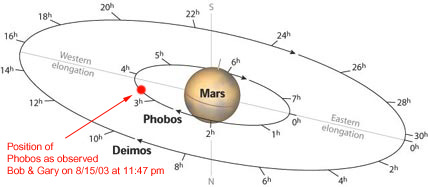 (original diagram from Sky &
Telescope web site)
(original diagram from Sky &
Telescope web site)
Phobos would not be visible without using
the occulting bar. The occulting bar that John installed is much
wider than Mars and blocked out most of the glare from Mars. The
bar being this wide at this magnification helped to improve contrast
for seeing Phobos. Here is the view using the occulting bar:
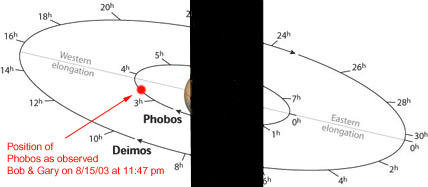
After checking on the computer for the positions
of the Martian satellites using the program SATEL13 by Francois
COLAS, we found that Deimos was also in a good position for observing.
we both tried to observe it without success. Deimos is dimmer
than Phobos, 11.6 Mag versus 10.5 Mag at this time of close approach
and some say should be easier to observe because it is farther
from the glare of Mars. I think that knowing where to look helps
in observing the Martian satellites and Phobos may be easier to
find since it can only be located in a small area, within about
one Mars diameter away.
We planned to image Phobos with the occulting
bar in place using a digital camera but my scope started to have
tracking problems and then clouds rolled in for the night.
The Sky & Telescope web site has a good
online article titled "The Martian Moons in 2003" by
Roger W. Sinnott and Adrian R. Ashford.
Image of Mars taken on 8/14/03 with the 20
inch Starmaster from my driveway using an Olympus C2020Z digital
camera, Meade 8.8 Ultrawide eyepiece and Televue 2X Big Barlow:
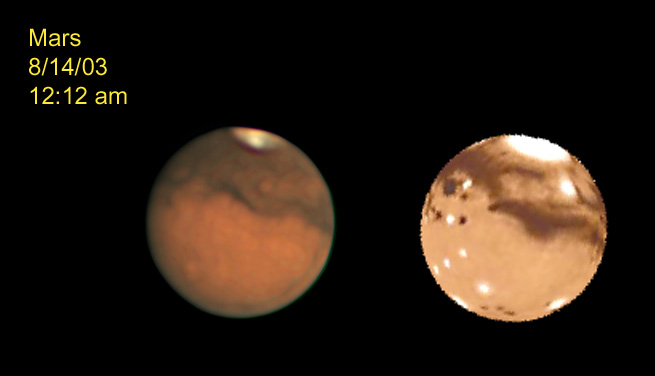
LATEST IMAGES:
 For images of M16 Eagle Nebula and Mars taken at Cherry
Springs 7/25-26/03 with a Canon 10D digital SLR, Olympus C2020Z
and Philips Vesta Pro webcam with a 20" Starmaster CLICK
HERE
For images of M16 Eagle Nebula and Mars taken at Cherry
Springs 7/25-26/03 with a Canon 10D digital SLR, Olympus C2020Z
and Philips Vesta Pro webcam with a 20" Starmaster CLICK
HERE
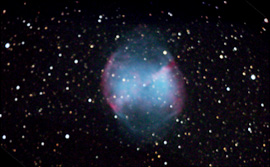 For images of M27 Dumbell Nebula and Mars taken at
Cherry Springs 7/4-5/03 with a Canon 10D digital SLR and Olympus
C2020Z with a 20" Starmaster CLICK
HERE
For images of M27 Dumbell Nebula and Mars taken at
Cherry Springs 7/4-5/03 with a Canon 10D digital SLR and Olympus
C2020Z with a 20" Starmaster CLICK
HERE
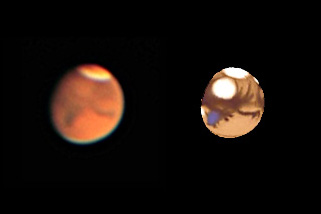 For images of Mars taken at Cherry Springs 6/28-29/03
with an Olympus C2020Z with a 20" Starmaster CLICK
HERE
For images of Mars taken at Cherry Springs 6/28-29/03
with an Olympus C2020Z with a 20" Starmaster CLICK
HERE
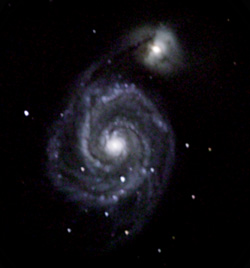 For images of M51 Whirlpool Galaxy taken on 5/18/03
with a Canon 10D, Denkmeier OCS and 20" Starmaster CLICK
HERE
For images of M51 Whirlpool Galaxy taken on 5/18/03
with a Canon 10D, Denkmeier OCS and 20" Starmaster CLICK
HERE
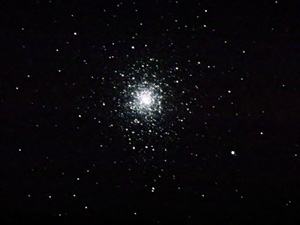 For images of M92, Moon & Mare Crisium taken on
5/5/03 with a Canon 10D, Denkmeier OCS and 20" Starmaster
CLICK HERE
For images of M92, Moon & Mare Crisium taken on
5/5/03 with a Canon 10D, Denkmeier OCS and 20" Starmaster
CLICK HERE
 For images of M51, M13, M57, M104, M27, M17, M81 &
M82 taken on 4/24-27/03 with a Canon 10D, Denkmeier OCS and 20"
Starmaster CLICK HERE
For images of M51, M13, M57, M104, M27, M17, M81 &
M82 taken on 4/24-27/03 with a Canon 10D, Denkmeier OCS and 20"
Starmaster CLICK HERE
Olympus C2000Z & C2020Z pages:
TO PART 8 - DEEP SKY IMAGES WITH
AIR-COOLED C2000Z
TO PART 7 - AIR_COOLING MODIFICATION
FOR C2000Z
TO PART 6 - DISASSEMBLY INSTRUCTIONS
FOR C2000Z
TO PART 5 - 32 SECOND IMAGES WITH
C2000Z
TO PART 4 - DEEP SKY IMAGING - LONG
EXPOSURES
TO PART 3 - DEEP SKY IMAGING ON 10/31/00
TO PART 2 - DEEP SKY IMAGING ON 10/20/00
TO PART 1 - DEEP SKY IMAGING WITH
2X BARLOW
TO MY DIGITAL CAMERA
IMAGING HOME PAGE
TO MY QUICKCAM PAGE
TO MY MAIN ASTROPHOTOGRAPHY PAGE


 (original diagram from Sky &
Telescope web site)
(original diagram from Sky &
Telescope web site)

 For images of M16 Eagle Nebula and Mars taken at Cherry
Springs 7/25-26/03 with a Canon 10D digital SLR, Olympus C2020Z
and Philips Vesta Pro webcam with a 20" Starmaster CLICK
HERE
For images of M16 Eagle Nebula and Mars taken at Cherry
Springs 7/25-26/03 with a Canon 10D digital SLR, Olympus C2020Z
and Philips Vesta Pro webcam with a 20" Starmaster CLICK
HERE For images of M27 Dumbell Nebula and Mars taken at
Cherry Springs 7/4-5/03 with a Canon 10D digital SLR and Olympus
C2020Z with a 20" Starmaster CLICK
HERE
For images of M27 Dumbell Nebula and Mars taken at
Cherry Springs 7/4-5/03 with a Canon 10D digital SLR and Olympus
C2020Z with a 20" Starmaster CLICK
HERE For images of Mars taken at Cherry Springs 6/28-29/03
with an Olympus C2020Z with a 20" Starmaster CLICK
HERE
For images of Mars taken at Cherry Springs 6/28-29/03
with an Olympus C2020Z with a 20" Starmaster CLICK
HERE For images of M51 Whirlpool Galaxy taken on 5/18/03
with a Canon 10D, Denkmeier OCS and 20" Starmaster CLICK
HERE
For images of M51 Whirlpool Galaxy taken on 5/18/03
with a Canon 10D, Denkmeier OCS and 20" Starmaster CLICK
HERE For images of M92, Moon & Mare Crisium taken on
5/5/03 with a Canon 10D, Denkmeier OCS and 20" Starmaster
CLICK HERE
For images of M92, Moon & Mare Crisium taken on
5/5/03 with a Canon 10D, Denkmeier OCS and 20" Starmaster
CLICK HERE For images of M51, M13, M57, M104, M27, M17, M81 &
M82 taken on 4/24-27/03 with a Canon 10D, Denkmeier OCS and 20"
Starmaster CLICK HERE
For images of M51, M13, M57, M104, M27, M17, M81 &
M82 taken on 4/24-27/03 with a Canon 10D, Denkmeier OCS and 20"
Starmaster CLICK HERE